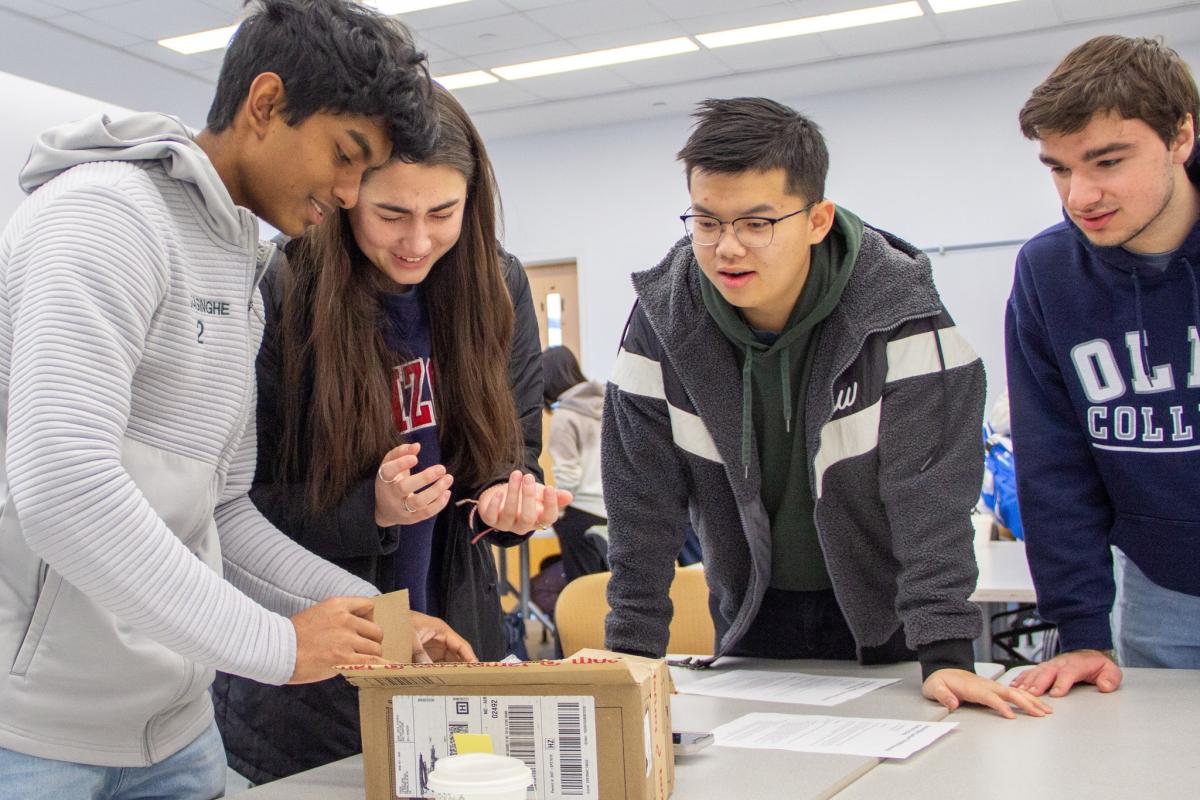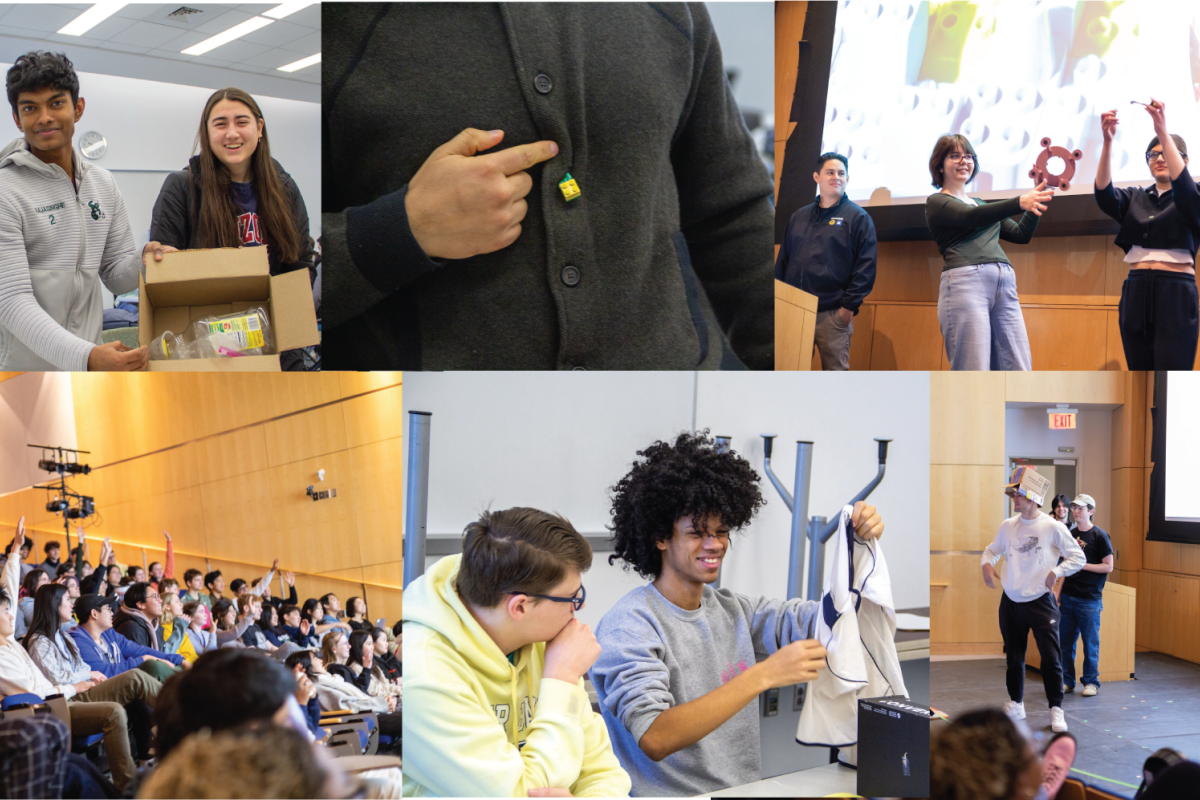STORY: P&M Students Participate in Speedy Sustainable Fashion Pitch
April 1, 2024
The Sustainable Fashion Entrepreneurship Kickbox Activity gave groups less than an hour to design and pitch an industry-changing innovation.
Students in Olin’s “Products and Markets” (P&M) class recently put their classroom knowledge to the test with a timed challenge to design and pitch an innovative product for the world of sustainable fashion.
Taken by all first-year students in their second semester, P&M takes the concept of entrepreneurship—a cornerstone of an Olin engineering education—and ensures that students see how it can be used to make a difference in the real world.
“Olin helps students learn to identify opportunities to make an impact toward the greater good and discover a menu of skills and perspectives that will help them pursue big ideas,” says Caitrin Lynch, professor of anthropology and co-instructor for P&M. “In this class, we want students to understand sustainability—the environmental, financial, and social aspects—and think through all of the complexities related to their ideas that they want to bring into the world.”

Products and Markets students, Class of 2027, working on their Fashion Entrepreneurship Kickbox Activity. Photo by Mira Chew '26.
This year’s P&M class is focused on deeply connecting the ideas of entrepreneurship and innovation to the United Nations’ Sustainable Development Goals (SDGs), which serve as a blueprint to transform the world by 2030.
“Tying the P&M curriculum to the SDGs was important to us pedagogically because these goals resonate with many of our students more strongly than 'entrepreneurship' as a general concept,” says another of the course’s co-instructors, Jason Woodard, professor of engineering and entrepreneurship as well as dean of external programs and partnerships. “Entrepreneurship is about changing the world, and using the SDGs to ground our teaching is valuable in getting to the world’s most challenging problems.”
Other faculty for “Products & Markets” include Sarah Bloomer, academic director of SCOPE and visiting professor of design; Donald Ger, adjunct instructor; and Alison Wood, associate professor of sustainability.
Quick Pitches with Kickbox Activity
The Sustainable Fashion Entrepreneurship Kickbox Activity was a mini challenge in between P&M students’ larger group projects. During the activity, student groups opened boxes containing various mystery items—such as rollerblades, a necktie, or an inflatable pink flamingo—which they used as inspiration to design a sustainable apparel innovation in under an hour. Student teams then pitched their ideas to Olin community members in the auditorium. Innovation ideas included an invasive species floral dye that reduces chemical waste; clothing made from recycled plastic water bottles; and resizable jeans.
“When Caitrin and Jason presented the idea of the Kickbox Activity, I thought it was incredible because it was fun for the students, but it also helped reinforce what they’ve been learning over the last few weeks,” says Moisés Sabido Garcia ’24, a senior who took P&M when he was a first-year student and has been the lead Course Assistant for the class for the past two years. “I’ve always had an entrepreneurial mindset, but I keep coming back to P&M because as I take more engineering courses, I continue to get more perspectives that affect my idea of entrepreneurship and how to create value in the world.”
“The Kickbox Activity was a great way to learn how to work quickly on a pitch and be confident,” says Katherine Danielson ’27, a current P&M student who wants to pursue a career as a liaison between engineering and business. “It was also a good opportunity to do team bonding with our new experiment groups and get on the same wavelength.
After this activity, students worked with their new teams to explore product-market fit for ideas related to the SDGs, going through a cycle of testing ideas and learning about them by interacting with potential real-world customers. The course goes through this cycle five times in the semester, enabling students to develop confidence with essential tools of entrepreneurship, and it culminates in an activity where students reflect on and make plans about how to carry this learning forward into their next several years at Olin.
“Using your technological skills for social good is dependent on how you see the world,” says Lynch. “Because everyone wears clothing, we figured creativity in this space would be meaningful to students. This was an opportunity to use fashion as a way to think critically about how to achieve product-market fit, and also to consider larger issues such as sustainable materials, climate change, the ethics of labor, and more.”
“The fashion activity was a chance to step back from spending two and a half weeks bootstrapping the foundational tools of the course and doing a more lightweight version,” echoes Woodard. “This is characteristic of Olin’s general approach to teaching and learning: intentionally using the same ideas in different contexts to reinforce them. This enables students to encounter core concepts at different tempos, in different situations, with different groups, and focused on different outputs—just like they will be doing as engineers and possibly entrepreneurs out in the real world after they graduate.”

P&M Fashion Sustainability collage spotlighting images from the kickbox. Photos by Mira Chew '26.